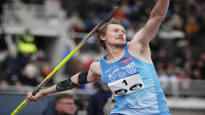On tax day, the taxable income of athletes is also monitored. Individual athletes are like private entrepreneurs and many have their own company.
15:35•Updated 15:48
Athletes’ incomes are reported because with the help of tax information, it is possible to have a discussion about income distribution in sports and, for example, wage equality. Information on the amount of income of top athletes also tells about how you can make money from sports in Finland.
Javelin thrower Lassi Etelätalo admits that August’s EC bronze will make it “somewhat” easier to get income.
– For a few years, the situation has been quite good, when the success of value competitions has reached the final level. At least there is no harm in success (for earning income), but it gives a good foundation for the next couple of years. There are at least a couple of years left in his career, the 34-year-old athlete told STT by phone.
He threw fourth in the 2019 World Championships in Doha, eighth in the 2021 Tokyo Olympics and sixth in the 2022 World Championships in Eugene. In Munich, the record 86.44 and the first prize competition medal were won.
The success has helped to get bigger grants and brought visibility in the sponsor market. In February, Etelätalo was once again awarded the Ministry of Education and Culture’s highest level tax-free athlete grant of 20,000 euros for one year.
– For an athlete of my level, it is the most important support for living. It is an income that comes in every month.
There are plenty of other sources of income when an individual athlete accumulates euros.
– In addition, there are the budgets that come through the association and the club, which are used for sports expenses.
– The money from the partners goes to the coaching fund, from where it can be used for sports or withdrawn with a tax card. Income from competitions, such as starting money, also works on the same principle.
An individual athlete is like a private entrepreneur, but Etelätalo does not have its own company.
– I have thought about establishing one. If there were more Instagram jobs and others, it would be easier to bill them through the company.
Athletes do not pay taxes on all the income they earn right away. An athlete’s career is short, so you have to prepare for life after your career in advance. Sports and coaching funds exist for this. You can find out more about their activities here.
Do you want a career in sports? We put together tips for young athletes. You can get to know them here.
Stealth runner Topi Raitase has an income of 74,000 euros
Pole vaulter Wilma Murron taxable income in 2021 was 29,000 euros and a hurdler Raitanen’s top 74,000 euros. Triple Jumper Kristiina Mäkelä earned 20,000 euros. About EUR 15,000 of Raitanen’s income was capital income. In Murru, the share of capital income was a good 2,000 euros.
A fencer Annimari Korte earned 71,000 euros, all of which was earned income. About quick-firers Reetta Hurske earned 39,000 euros and Nooralotta Neziri 69,000 euros. Nezir accumulated capital gains of almost 4,000 euros. 400m hurdler Viivi Lehikonen taxable income was 5,400 euros.
About javelin throwers Toni Kuusela 23,000 and Oliver Helander 15,000 euros. Scoundrel thrower Silja Kosonen earned 10,000 euros.
Middle distance runner Sara Lappalainen (née Kuivisto) received an income of 40,000 euros, of which capital income was just under 4,000 euros.
Olympic medalist Mattsson earned around 13,000 euros
Swimmer Matti Mattsson’s taxable income in 2021 was 13,000 euros. Boxer Mira Potkonen earned 29,000 euros, of which 2,000 were capital gains.
Track winder Leo-Pekka Tähten taxable income was 2,000 euros, of which capital income accounted for 400 euros.
Skeet shooter Eetu Kallioinen income was 21,000 euros. Sailing in the Laser radial class Tuula Tenkanen earned 23,000 euros.
Pärmäkoski and Hakola beat Niskase
Cross-country skier Iivo Niskanen taxable income in 2021 was 47,000 euros, Kerttu Niskanen 13,000 euros and Krista Pärmäkoski 74,000 euros. 7,000 euros of Iivo Niskanen’s income was capital income, but the biggest part of big sister Kertu’s income, 11,000 euros, was capital income. Pärmäkoski’s capital income was less than 5,000 euros.
In addition to Pärmäkoski, also Cross mat Hakola earned more than Niskas. Hakola’s taxable income was EUR 74,000, of which EUR 13,000 was capital income. Johanna Matintalo earned 55,000 euros and Jasmi Joensuu 24,000 euros. The capital income of the latter was almost 23,000 euros. Ilkka Herola collected 65,000 euros, of which almost 3,000 euros were capital income.
Among the representatives of other snow sports, a snowboarder Enni Rukajärvi collected 43,000 euros, of which no less than 22,000 were capital income. Rene Rinnekangas received 32,000 euros.
Urheilu collected the athletes’ taxable income for this article.
